Managerial Economics Report: Samsung Market Analysis and Structure
VerifiedAdded on 2023/01/19
|13
|3633
|38
Report
AI Summary
This report provides a comprehensive analysis of Samsung, a leading multinational electronics company, examining its market position, products, and historical evolution. It delves into the application of managerial economics principles to understand Samsung's strategies in the consumer electronics market, focusing on market structure, particularly the transition from oligopoly to a more competitive landscape. The report analyzes Samsung's market share, revenue, and competitive advantages, including its innovative technologies like QLED and AMOLED screens. Furthermore, it discusses the impact of government interventions and suggests potential strategies for optimal market performance, considering both the benefits to the company and broader societal implications. The report highlights Samsung's responses to market changes, its efforts to maintain a competitive edge through innovation, and its financial strength to invest in research and development. The report explores the dynamic shift in the TV market and the impact of new entrants, emphasizing the need for continuous innovation and adaptation in the face of evolving market structures.
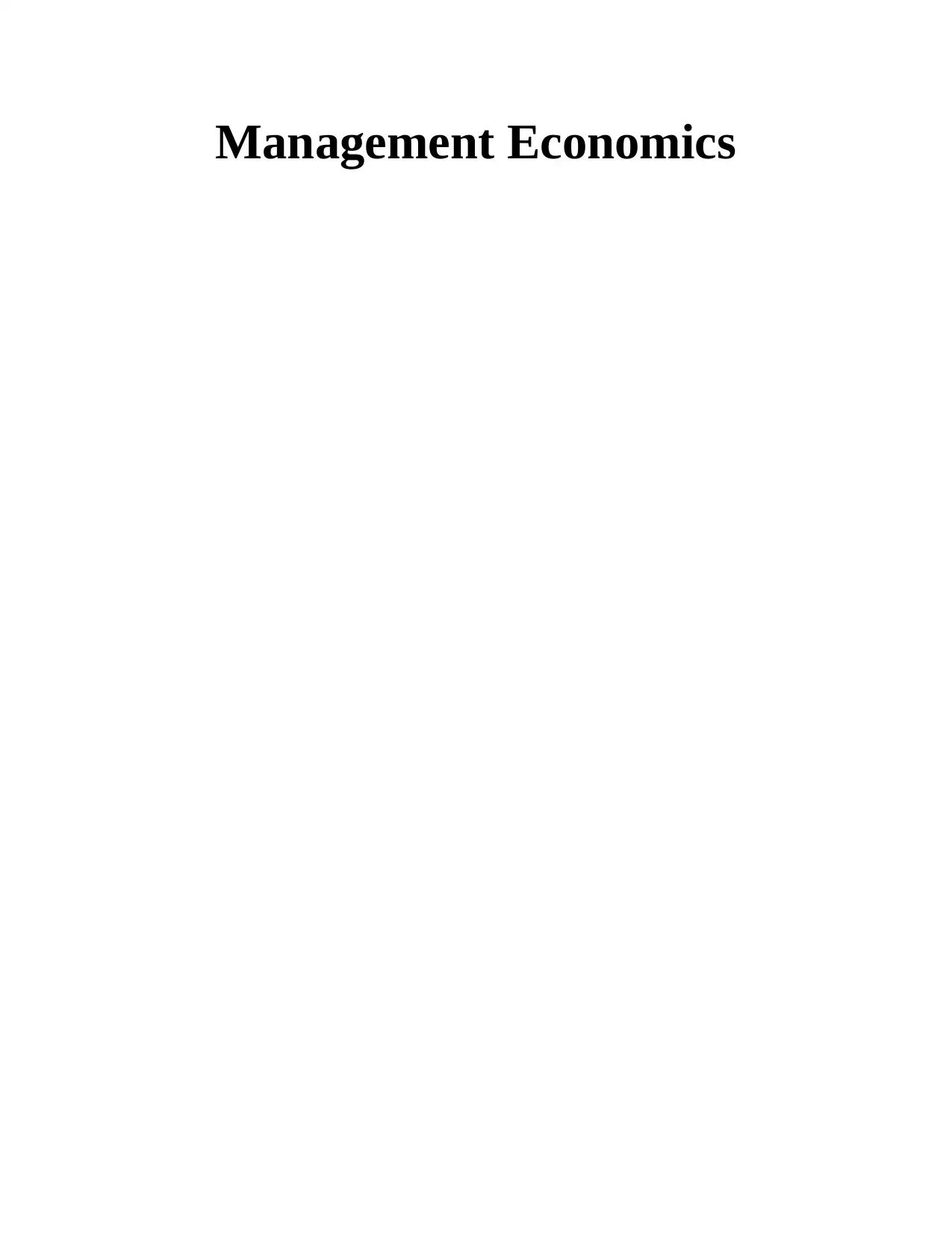
Management Economics
Paraphrase This Document
Need a fresh take? Get an instant paraphrase of this document with our AI Paraphraser

Table of Contents
INTRODUCTION...........................................................................................................................1
1. Overview of Company, its products/services and history..................................................1
2. Market Analysis of Samsung with market structure..........................................................2
3. Characteristics of previous and current market structure...................................................4
4. a) Discussion on whether operating in different market structure proves optimal for
Samsung.................................................................................................................................7
4. b) Suggestions for lesser or greater government interventions..........................................8
CONCLUSION................................................................................................................................8
REFERENCES................................................................................................................................9
INTRODUCTION...........................................................................................................................1
1. Overview of Company, its products/services and history..................................................1
2. Market Analysis of Samsung with market structure..........................................................2
3. Characteristics of previous and current market structure...................................................4
4. a) Discussion on whether operating in different market structure proves optimal for
Samsung.................................................................................................................................7
4. b) Suggestions for lesser or greater government interventions..........................................8
CONCLUSION................................................................................................................................8
REFERENCES................................................................................................................................9

⊘ This is a preview!⊘
Do you want full access?
Subscribe today to unlock all pages.

Trusted by 1+ million students worldwide

INTRODUCTION
Managerial economics deals with a number of economic concepts, tools, methodologies
and theories, for solving a specific problems of business (Grajek and et. al. 2019). It acts as a link
among business practices and theoretical aspects, that helps management of a company in taking
effective decisions (Gottinger, 2018). To optimise business decisions, various techniques like
microeconomic can be applied on production and pricing analysis; financial economics on
capital budgeting and more. The present report is going to elaborate how managerial economics
aid a firm, in increasing its performance. Samsung is chosen for this purpose, that considers as
the largest television manufacturer of entire world. An in-depth knowledge with previous and
current history of this organisation is detailed under this project. Along with this, nature of
market in terms of monopoly and oligopoly also defines systematically. Furthermore,
suggestions for lesser or greater government intervention are discussion to find benefits for
society.
1. Overview of Company, its products/services and history
Samsung Electronics Co. Ltd, is a multinational electronics company that headquartered
in South Korea, in 1969. It is considered as the world's largest manufacturer in electronics
products especially in television sector, that operates business in more than 80 countries,
including UK (Banks, 2018). The products of this company broadly classified into three main
categories as consumer electronics, semiconductors and home appliances, with a range of items
of each category. By talking about its range in consumer electronics, it has been evaluated that
Samsung offers DVD players, TVs, communication devices like mobile phones, housekeeping
goods such as washing machine and refrigerators etc. The first product with a number of
electronic-focuses division of Samsung includes Black & White Television, in 1969. Afterwards,
with continue development of technology, it has manufactured several products that range from
semiconductors to LCD Screens (Maniou and Seitanidis, 2018). This would aid Samsung to
climb at top-five position within global market share.
In television industry, this company has grabbed over 20% market share, as per
worldwide report, where in 2010, it has launched fully HD LED TV at Las Vegas. This
electronic firm also accounts to sale almost 50% of total television (75-inch TV) worldwide, that
enables to gain high competitive advantage over other companies, like Sony, Haier, Panasonic
1
Managerial economics deals with a number of economic concepts, tools, methodologies
and theories, for solving a specific problems of business (Grajek and et. al. 2019). It acts as a link
among business practices and theoretical aspects, that helps management of a company in taking
effective decisions (Gottinger, 2018). To optimise business decisions, various techniques like
microeconomic can be applied on production and pricing analysis; financial economics on
capital budgeting and more. The present report is going to elaborate how managerial economics
aid a firm, in increasing its performance. Samsung is chosen for this purpose, that considers as
the largest television manufacturer of entire world. An in-depth knowledge with previous and
current history of this organisation is detailed under this project. Along with this, nature of
market in terms of monopoly and oligopoly also defines systematically. Furthermore,
suggestions for lesser or greater government intervention are discussion to find benefits for
society.
1. Overview of Company, its products/services and history
Samsung Electronics Co. Ltd, is a multinational electronics company that headquartered
in South Korea, in 1969. It is considered as the world's largest manufacturer in electronics
products especially in television sector, that operates business in more than 80 countries,
including UK (Banks, 2018). The products of this company broadly classified into three main
categories as consumer electronics, semiconductors and home appliances, with a range of items
of each category. By talking about its range in consumer electronics, it has been evaluated that
Samsung offers DVD players, TVs, communication devices like mobile phones, housekeeping
goods such as washing machine and refrigerators etc. The first product with a number of
electronic-focuses division of Samsung includes Black & White Television, in 1969. Afterwards,
with continue development of technology, it has manufactured several products that range from
semiconductors to LCD Screens (Maniou and Seitanidis, 2018). This would aid Samsung to
climb at top-five position within global market share.
In television industry, this company has grabbed over 20% market share, as per
worldwide report, where in 2010, it has launched fully HD LED TV at Las Vegas. This
electronic firm also accounts to sale almost 50% of total television (75-inch TV) worldwide, that
enables to gain high competitive advantage over other companies, like Sony, Haier, Panasonic
1
Paraphrase This Document
Need a fresh take? Get an instant paraphrase of this document with our AI Paraphraser
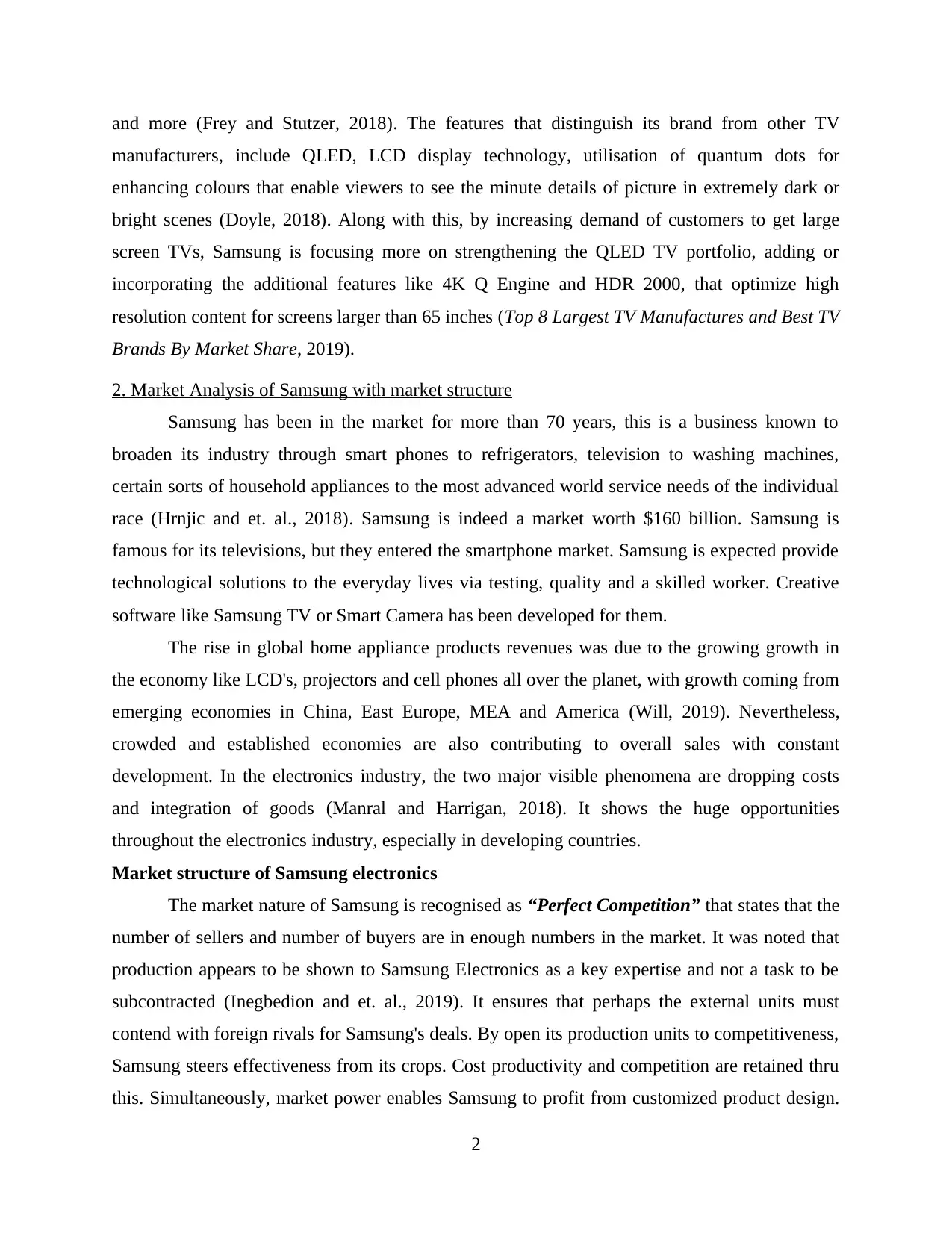
and more (Frey and Stutzer, 2018). The features that distinguish its brand from other TV
manufacturers, include QLED, LCD display technology, utilisation of quantum dots for
enhancing colours that enable viewers to see the minute details of picture in extremely dark or
bright scenes (Doyle, 2018). Along with this, by increasing demand of customers to get large
screen TVs, Samsung is focusing more on strengthening the QLED TV portfolio, adding or
incorporating the additional features like 4K Q Engine and HDR 2000, that optimize high
resolution content for screens larger than 65 inches (Top 8 Largest TV Manufactures and Best TV
Brands By Market Share, 2019).
2. Market Analysis of Samsung with market structure
Samsung has been in the market for more than 70 years, this is a business known to
broaden its industry through smart phones to refrigerators, television to washing machines,
certain sorts of household appliances to the most advanced world service needs of the individual
race (Hrnjic and et. al., 2018). Samsung is indeed a market worth $160 billion. Samsung is
famous for its televisions, but they entered the smartphone market. Samsung is expected provide
technological solutions to the everyday lives via testing, quality and a skilled worker. Creative
software like Samsung TV or Smart Camera has been developed for them.
The rise in global home appliance products revenues was due to the growing growth in
the economy like LCD's, projectors and cell phones all over the planet, with growth coming from
emerging economies in China, East Europe, MEA and America (Will, 2019). Nevertheless,
crowded and established economies are also contributing to overall sales with constant
development. In the electronics industry, the two major visible phenomena are dropping costs
and integration of goods (Manral and Harrigan, 2018). It shows the huge opportunities
throughout the electronics industry, especially in developing countries.
Market structure of Samsung electronics
The market nature of Samsung is recognised as “Perfect Competition” that states that the
number of sellers and number of buyers are in enough numbers in the market. It was noted that
production appears to be shown to Samsung Electronics as a key expertise and not a task to be
subcontracted (Inegbedion and et. al., 2019). It ensures that perhaps the external units must
contend with foreign rivals for Samsung's deals. By open its production units to competitiveness,
Samsung steers effectiveness from its crops. Cost productivity and competition are retained thru
this. Simultaneously, market power enables Samsung to profit from customized product design.
2
manufacturers, include QLED, LCD display technology, utilisation of quantum dots for
enhancing colours that enable viewers to see the minute details of picture in extremely dark or
bright scenes (Doyle, 2018). Along with this, by increasing demand of customers to get large
screen TVs, Samsung is focusing more on strengthening the QLED TV portfolio, adding or
incorporating the additional features like 4K Q Engine and HDR 2000, that optimize high
resolution content for screens larger than 65 inches (Top 8 Largest TV Manufactures and Best TV
Brands By Market Share, 2019).
2. Market Analysis of Samsung with market structure
Samsung has been in the market for more than 70 years, this is a business known to
broaden its industry through smart phones to refrigerators, television to washing machines,
certain sorts of household appliances to the most advanced world service needs of the individual
race (Hrnjic and et. al., 2018). Samsung is indeed a market worth $160 billion. Samsung is
famous for its televisions, but they entered the smartphone market. Samsung is expected provide
technological solutions to the everyday lives via testing, quality and a skilled worker. Creative
software like Samsung TV or Smart Camera has been developed for them.
The rise in global home appliance products revenues was due to the growing growth in
the economy like LCD's, projectors and cell phones all over the planet, with growth coming from
emerging economies in China, East Europe, MEA and America (Will, 2019). Nevertheless,
crowded and established economies are also contributing to overall sales with constant
development. In the electronics industry, the two major visible phenomena are dropping costs
and integration of goods (Manral and Harrigan, 2018). It shows the huge opportunities
throughout the electronics industry, especially in developing countries.
Market structure of Samsung electronics
The market nature of Samsung is recognised as “Perfect Competition” that states that the
number of sellers and number of buyers are in enough numbers in the market. It was noted that
production appears to be shown to Samsung Electronics as a key expertise and not a task to be
subcontracted (Inegbedion and et. al., 2019). It ensures that perhaps the external units must
contend with foreign rivals for Samsung's deals. By open its production units to competitiveness,
Samsung steers effectiveness from its crops. Cost productivity and competition are retained thru
this. Simultaneously, market power enables Samsung to profit from customized product design.
2
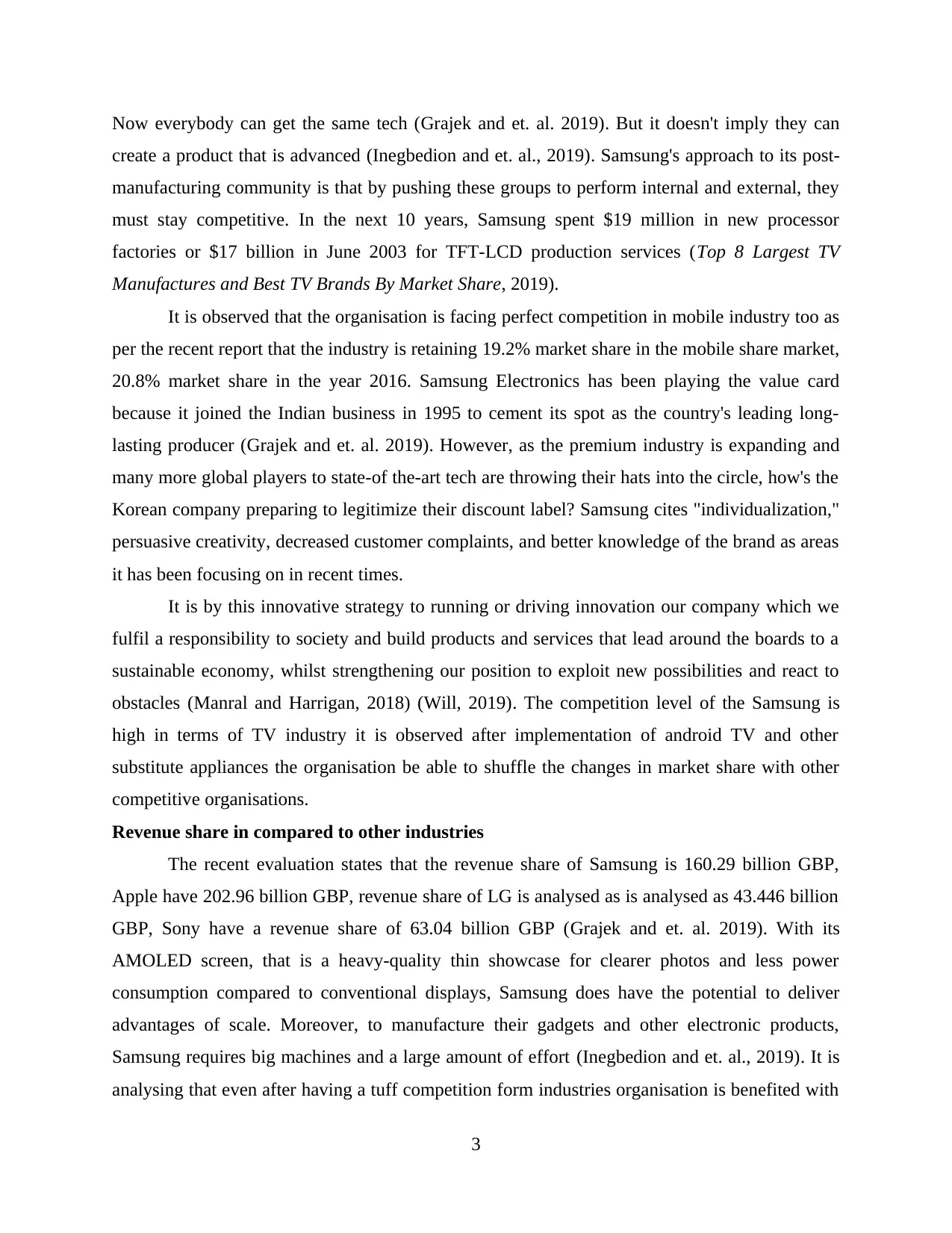
Now everybody can get the same tech (Grajek and et. al. 2019). But it doesn't imply they can
create a product that is advanced (Inegbedion and et. al., 2019). Samsung's approach to its post-
manufacturing community is that by pushing these groups to perform internal and external, they
must stay competitive. In the next 10 years, Samsung spent $19 million in new processor
factories or $17 billion in June 2003 for TFT-LCD production services (Top 8 Largest TV
Manufactures and Best TV Brands By Market Share, 2019).
It is observed that the organisation is facing perfect competition in mobile industry too as
per the recent report that the industry is retaining 19.2% market share in the mobile share market,
20.8% market share in the year 2016. Samsung Electronics has been playing the value card
because it joined the Indian business in 1995 to cement its spot as the country's leading long-
lasting producer (Grajek and et. al. 2019). However, as the premium industry is expanding and
many more global players to state-of the-art tech are throwing their hats into the circle, how's the
Korean company preparing to legitimize their discount label? Samsung cites "individualization,"
persuasive creativity, decreased customer complaints, and better knowledge of the brand as areas
it has been focusing on in recent times.
It is by this innovative strategy to running or driving innovation our company which we
fulfil a responsibility to society and build products and services that lead around the boards to a
sustainable economy, whilst strengthening our position to exploit new possibilities and react to
obstacles (Manral and Harrigan, 2018) (Will, 2019). The competition level of the Samsung is
high in terms of TV industry it is observed after implementation of android TV and other
substitute appliances the organisation be able to shuffle the changes in market share with other
competitive organisations.
Revenue share in compared to other industries
The recent evaluation states that the revenue share of Samsung is 160.29 billion GBP,
Apple have 202.96 billion GBP, revenue share of LG is analysed as is analysed as 43.446 billion
GBP, Sony have a revenue share of 63.04 billion GBP (Grajek and et. al. 2019). With its
AMOLED screen, that is a heavy-quality thin showcase for clearer photos and less power
consumption compared to conventional displays, Samsung does have the potential to deliver
advantages of scale. Moreover, to manufacture their gadgets and other electronic products,
Samsung requires big machines and a large amount of effort (Inegbedion and et. al., 2019). It is
analysing that even after having a tuff competition form industries organisation is benefited with
3
create a product that is advanced (Inegbedion and et. al., 2019). Samsung's approach to its post-
manufacturing community is that by pushing these groups to perform internal and external, they
must stay competitive. In the next 10 years, Samsung spent $19 million in new processor
factories or $17 billion in June 2003 for TFT-LCD production services (Top 8 Largest TV
Manufactures and Best TV Brands By Market Share, 2019).
It is observed that the organisation is facing perfect competition in mobile industry too as
per the recent report that the industry is retaining 19.2% market share in the mobile share market,
20.8% market share in the year 2016. Samsung Electronics has been playing the value card
because it joined the Indian business in 1995 to cement its spot as the country's leading long-
lasting producer (Grajek and et. al. 2019). However, as the premium industry is expanding and
many more global players to state-of the-art tech are throwing their hats into the circle, how's the
Korean company preparing to legitimize their discount label? Samsung cites "individualization,"
persuasive creativity, decreased customer complaints, and better knowledge of the brand as areas
it has been focusing on in recent times.
It is by this innovative strategy to running or driving innovation our company which we
fulfil a responsibility to society and build products and services that lead around the boards to a
sustainable economy, whilst strengthening our position to exploit new possibilities and react to
obstacles (Manral and Harrigan, 2018) (Will, 2019). The competition level of the Samsung is
high in terms of TV industry it is observed after implementation of android TV and other
substitute appliances the organisation be able to shuffle the changes in market share with other
competitive organisations.
Revenue share in compared to other industries
The recent evaluation states that the revenue share of Samsung is 160.29 billion GBP,
Apple have 202.96 billion GBP, revenue share of LG is analysed as is analysed as 43.446 billion
GBP, Sony have a revenue share of 63.04 billion GBP (Grajek and et. al. 2019). With its
AMOLED screen, that is a heavy-quality thin showcase for clearer photos and less power
consumption compared to conventional displays, Samsung does have the potential to deliver
advantages of scale. Moreover, to manufacture their gadgets and other electronic products,
Samsung requires big machines and a large amount of effort (Inegbedion and et. al., 2019). It is
analysing that even after having a tuff competition form industries organisation is benefited with
3
⊘ This is a preview!⊘
Do you want full access?
Subscribe today to unlock all pages.

Trusted by 1+ million students worldwide
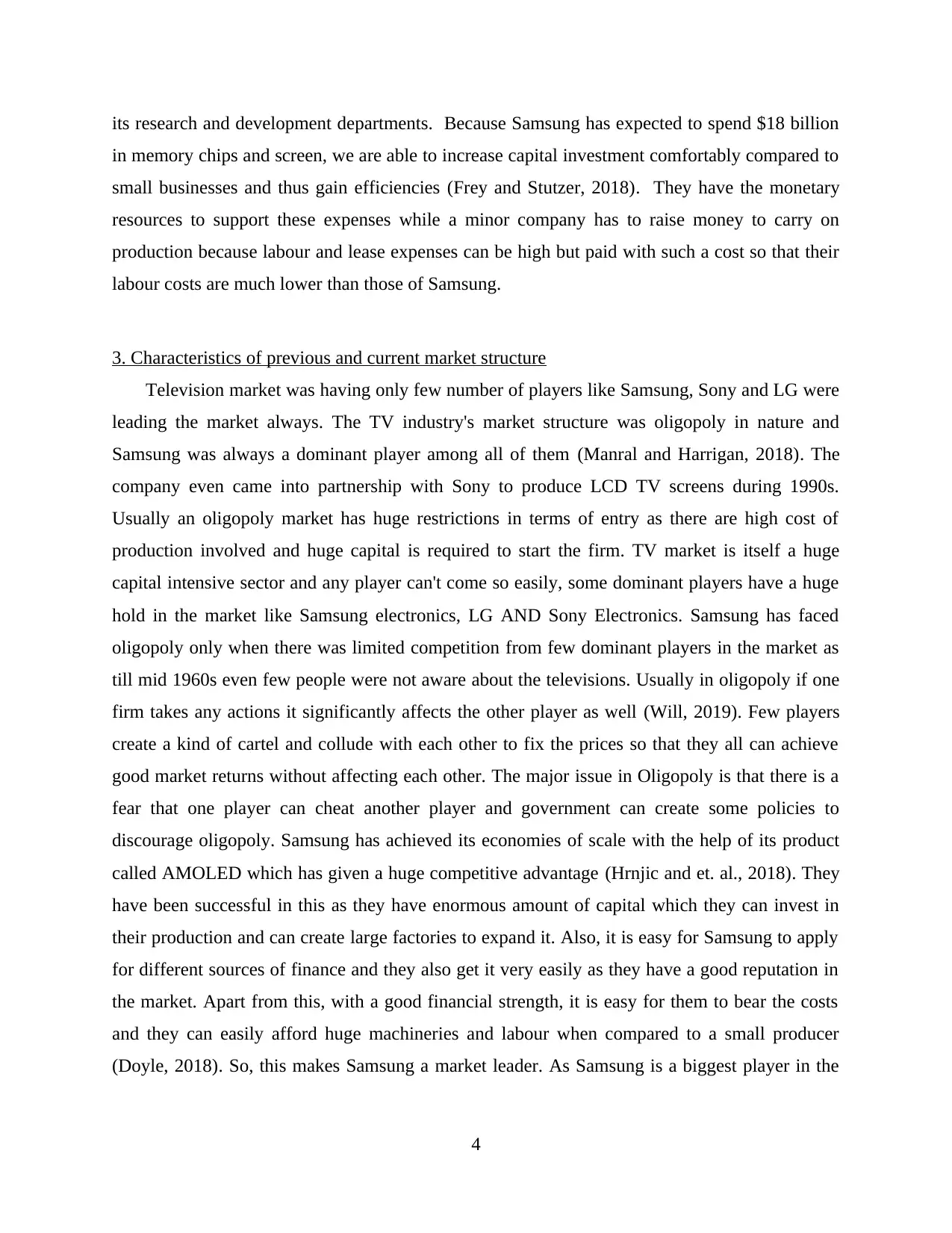
its research and development departments. Because Samsung has expected to spend $18 billion
in memory chips and screen, we are able to increase capital investment comfortably compared to
small businesses and thus gain efficiencies (Frey and Stutzer, 2018). They have the monetary
resources to support these expenses while a minor company has to raise money to carry on
production because labour and lease expenses can be high but paid with such a cost so that their
labour costs are much lower than those of Samsung.
3. Characteristics of previous and current market structure
Television market was having only few number of players like Samsung, Sony and LG were
leading the market always. The TV industry's market structure was oligopoly in nature and
Samsung was always a dominant player among all of them (Manral and Harrigan, 2018). The
company even came into partnership with Sony to produce LCD TV screens during 1990s.
Usually an oligopoly market has huge restrictions in terms of entry as there are high cost of
production involved and huge capital is required to start the firm. TV market is itself a huge
capital intensive sector and any player can't come so easily, some dominant players have a huge
hold in the market like Samsung electronics, LG AND Sony Electronics. Samsung has faced
oligopoly only when there was limited competition from few dominant players in the market as
till mid 1960s even few people were not aware about the televisions. Usually in oligopoly if one
firm takes any actions it significantly affects the other player as well (Will, 2019). Few players
create a kind of cartel and collude with each other to fix the prices so that they all can achieve
good market returns without affecting each other. The major issue in Oligopoly is that there is a
fear that one player can cheat another player and government can create some policies to
discourage oligopoly. Samsung has achieved its economies of scale with the help of its product
called AMOLED which has given a huge competitive advantage (Hrnjic and et. al., 2018). They
have been successful in this as they have enormous amount of capital which they can invest in
their production and can create large factories to expand it. Also, it is easy for Samsung to apply
for different sources of finance and they also get it very easily as they have a good reputation in
the market. Apart from this, with a good financial strength, it is easy for them to bear the costs
and they can easily afford huge machineries and labour when compared to a small producer
(Doyle, 2018). So, this makes Samsung a market leader. As Samsung is a biggest player in the
4
in memory chips and screen, we are able to increase capital investment comfortably compared to
small businesses and thus gain efficiencies (Frey and Stutzer, 2018). They have the monetary
resources to support these expenses while a minor company has to raise money to carry on
production because labour and lease expenses can be high but paid with such a cost so that their
labour costs are much lower than those of Samsung.
3. Characteristics of previous and current market structure
Television market was having only few number of players like Samsung, Sony and LG were
leading the market always. The TV industry's market structure was oligopoly in nature and
Samsung was always a dominant player among all of them (Manral and Harrigan, 2018). The
company even came into partnership with Sony to produce LCD TV screens during 1990s.
Usually an oligopoly market has huge restrictions in terms of entry as there are high cost of
production involved and huge capital is required to start the firm. TV market is itself a huge
capital intensive sector and any player can't come so easily, some dominant players have a huge
hold in the market like Samsung electronics, LG AND Sony Electronics. Samsung has faced
oligopoly only when there was limited competition from few dominant players in the market as
till mid 1960s even few people were not aware about the televisions. Usually in oligopoly if one
firm takes any actions it significantly affects the other player as well (Will, 2019). Few players
create a kind of cartel and collude with each other to fix the prices so that they all can achieve
good market returns without affecting each other. The major issue in Oligopoly is that there is a
fear that one player can cheat another player and government can create some policies to
discourage oligopoly. Samsung has achieved its economies of scale with the help of its product
called AMOLED which has given a huge competitive advantage (Hrnjic and et. al., 2018). They
have been successful in this as they have enormous amount of capital which they can invest in
their production and can create large factories to expand it. Also, it is easy for Samsung to apply
for different sources of finance and they also get it very easily as they have a good reputation in
the market. Apart from this, with a good financial strength, it is easy for them to bear the costs
and they can easily afford huge machineries and labour when compared to a small producer
(Doyle, 2018). So, this makes Samsung a market leader. As Samsung is a biggest player in the
4
Paraphrase This Document
Need a fresh take? Get an instant paraphrase of this document with our AI Paraphraser
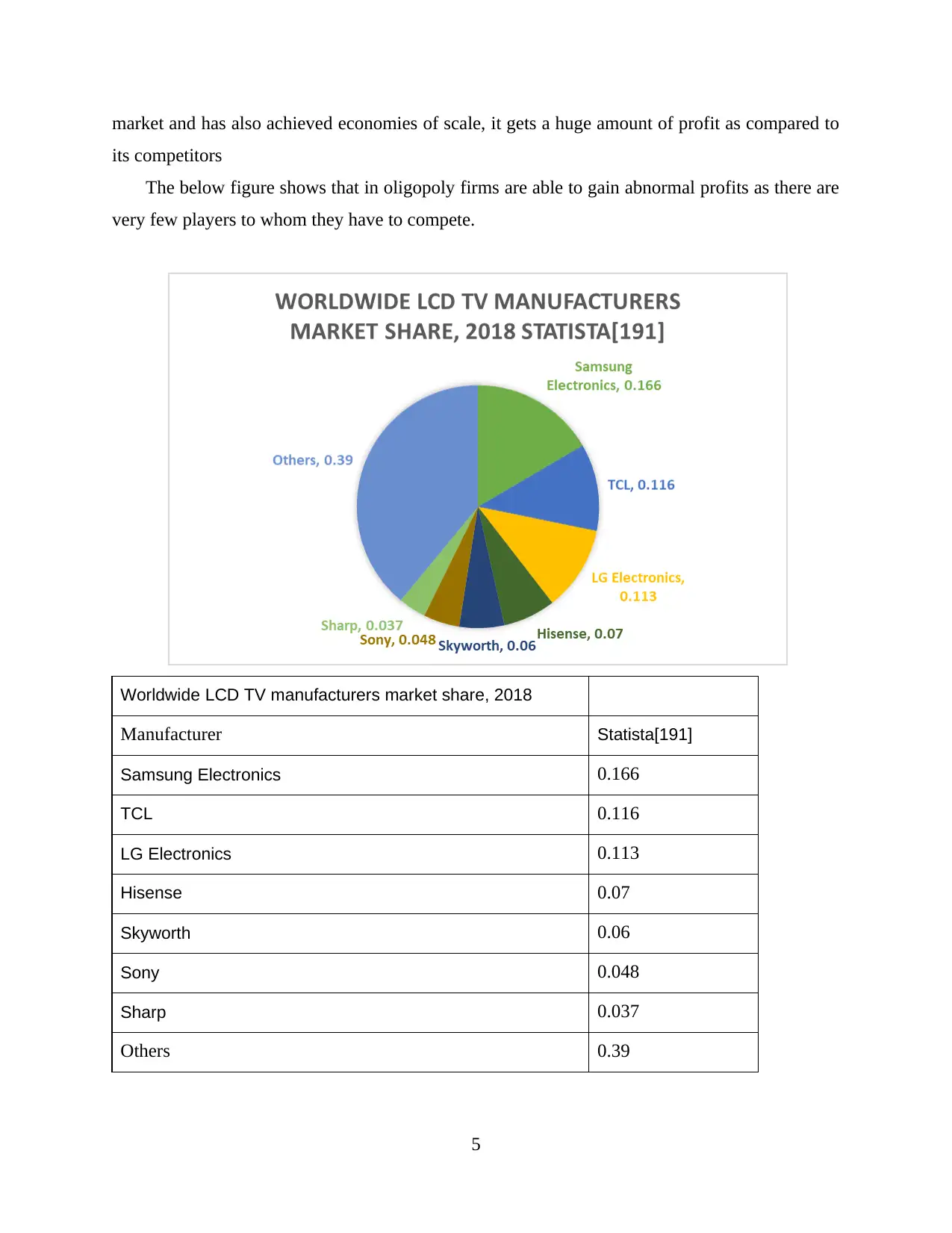
market and has also achieved economies of scale, it gets a huge amount of profit as compared to
its competitors
The below figure shows that in oligopoly firms are able to gain abnormal profits as there are
very few players to whom they have to compete.
Worldwide LCD TV manufacturers market share, 2018
Manufacturer Statista[191]
Samsung Electronics 0.166
TCL 0.116
LG Electronics 0.113
Hisense 0.07
Skyworth 0.06
Sony 0.048
Sharp 0.037
Others 0.39
5
its competitors
The below figure shows that in oligopoly firms are able to gain abnormal profits as there are
very few players to whom they have to compete.
Worldwide LCD TV manufacturers market share, 2018
Manufacturer Statista[191]
Samsung Electronics 0.166
TCL 0.116
LG Electronics 0.113
Hisense 0.07
Skyworth 0.06
Sony 0.048
Sharp 0.037
Others 0.39
5
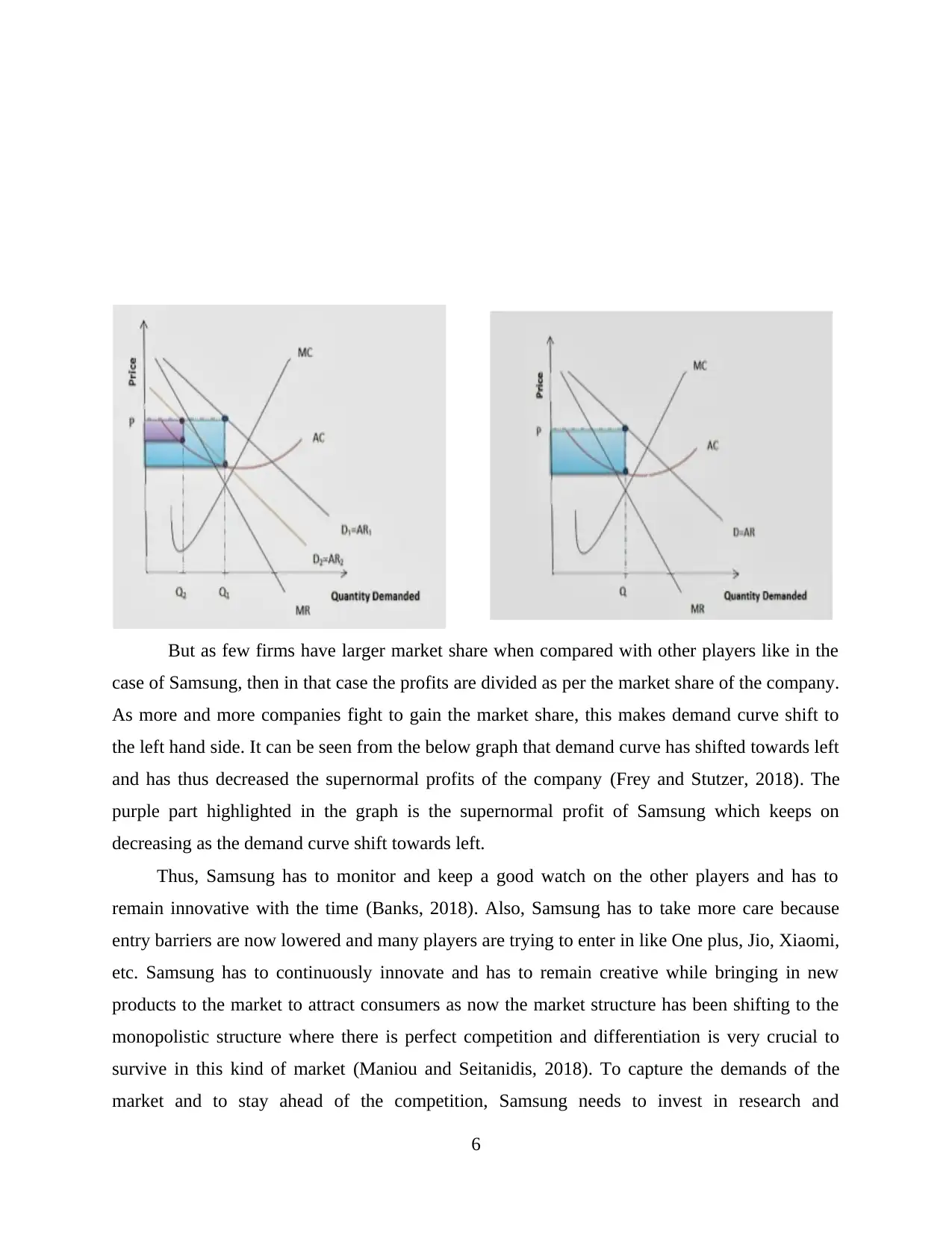
But as few firms have larger market share when compared with other players like in the
case of Samsung, then in that case the profits are divided as per the market share of the company.
As more and more companies fight to gain the market share, this makes demand curve shift to
the left hand side. It can be seen from the below graph that demand curve has shifted towards left
and has thus decreased the supernormal profits of the company (Frey and Stutzer, 2018). The
purple part highlighted in the graph is the supernormal profit of Samsung which keeps on
decreasing as the demand curve shift towards left.
Thus, Samsung has to monitor and keep a good watch on the other players and has to
remain innovative with the time (Banks, 2018). Also, Samsung has to take more care because
entry barriers are now lowered and many players are trying to enter in like One plus, Jio, Xiaomi,
etc. Samsung has to continuously innovate and has to remain creative while bringing in new
products to the market to attract consumers as now the market structure has been shifting to the
monopolistic structure where there is perfect competition and differentiation is very crucial to
survive in this kind of market (Maniou and Seitanidis, 2018). To capture the demands of the
market and to stay ahead of the competition, Samsung needs to invest in research and
6
case of Samsung, then in that case the profits are divided as per the market share of the company.
As more and more companies fight to gain the market share, this makes demand curve shift to
the left hand side. It can be seen from the below graph that demand curve has shifted towards left
and has thus decreased the supernormal profits of the company (Frey and Stutzer, 2018). The
purple part highlighted in the graph is the supernormal profit of Samsung which keeps on
decreasing as the demand curve shift towards left.
Thus, Samsung has to monitor and keep a good watch on the other players and has to
remain innovative with the time (Banks, 2018). Also, Samsung has to take more care because
entry barriers are now lowered and many players are trying to enter in like One plus, Jio, Xiaomi,
etc. Samsung has to continuously innovate and has to remain creative while bringing in new
products to the market to attract consumers as now the market structure has been shifting to the
monopolistic structure where there is perfect competition and differentiation is very crucial to
survive in this kind of market (Maniou and Seitanidis, 2018). To capture the demands of the
market and to stay ahead of the competition, Samsung needs to invest in research and
6
⊘ This is a preview!⊘
Do you want full access?
Subscribe today to unlock all pages.

Trusted by 1+ million students worldwide
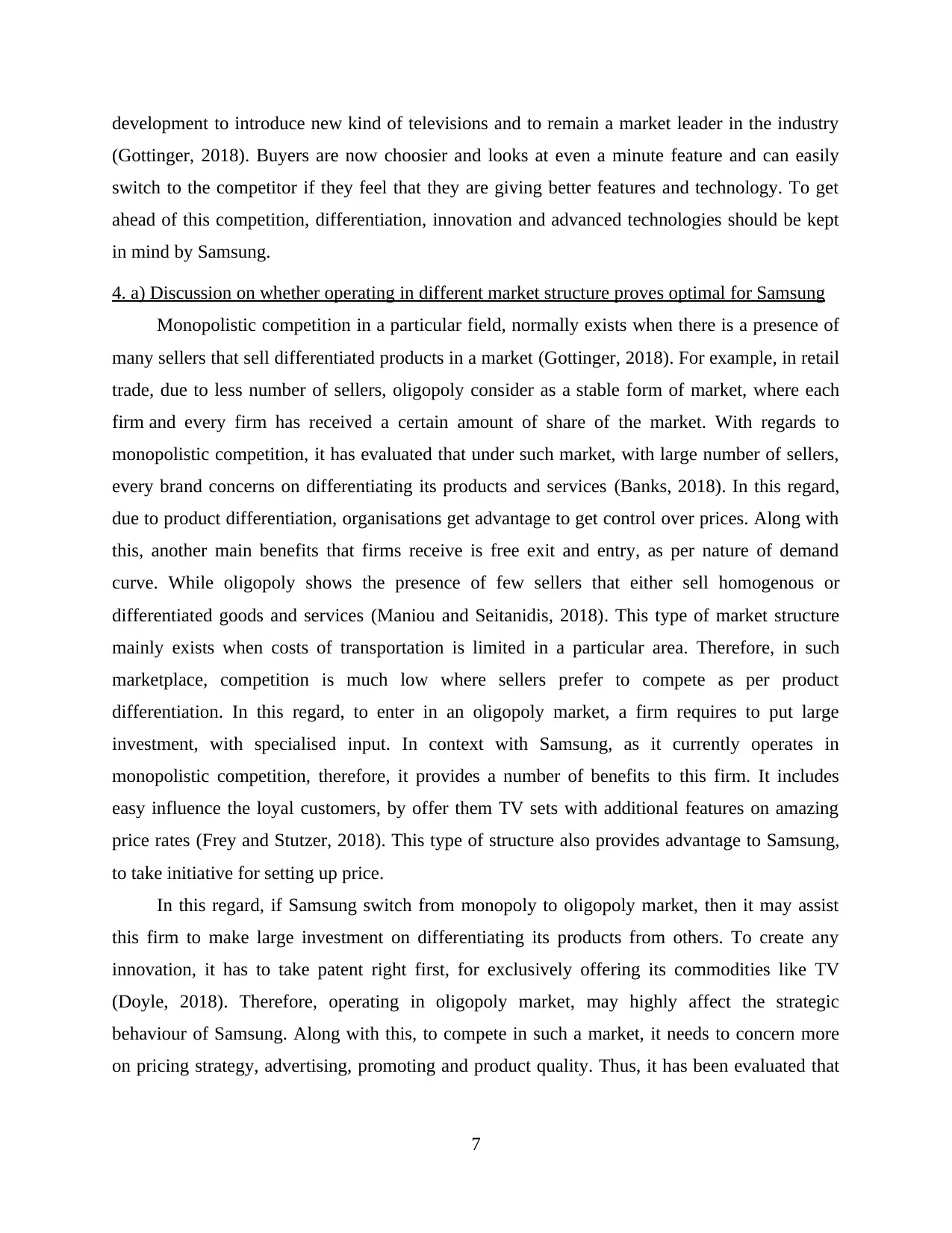
development to introduce new kind of televisions and to remain a market leader in the industry
(Gottinger, 2018). Buyers are now choosier and looks at even a minute feature and can easily
switch to the competitor if they feel that they are giving better features and technology. To get
ahead of this competition, differentiation, innovation and advanced technologies should be kept
in mind by Samsung.
4. a) Discussion on whether operating in different market structure proves optimal for Samsung
Monopolistic competition in a particular field, normally exists when there is a presence of
many sellers that sell differentiated products in a market (Gottinger, 2018). For example, in retail
trade, due to less number of sellers, oligopoly consider as a stable form of market, where each
firm and every firm has received a certain amount of share of the market. With regards to
monopolistic competition, it has evaluated that under such market, with large number of sellers,
every brand concerns on differentiating its products and services (Banks, 2018). In this regard,
due to product differentiation, organisations get advantage to get control over prices. Along with
this, another main benefits that firms receive is free exit and entry, as per nature of demand
curve. While oligopoly shows the presence of few sellers that either sell homogenous or
differentiated goods and services (Maniou and Seitanidis, 2018). This type of market structure
mainly exists when costs of transportation is limited in a particular area. Therefore, in such
marketplace, competition is much low where sellers prefer to compete as per product
differentiation. In this regard, to enter in an oligopoly market, a firm requires to put large
investment, with specialised input. In context with Samsung, as it currently operates in
monopolistic competition, therefore, it provides a number of benefits to this firm. It includes
easy influence the loyal customers, by offer them TV sets with additional features on amazing
price rates (Frey and Stutzer, 2018). This type of structure also provides advantage to Samsung,
to take initiative for setting up price.
In this regard, if Samsung switch from monopoly to oligopoly market, then it may assist
this firm to make large investment on differentiating its products from others. To create any
innovation, it has to take patent right first, for exclusively offering its commodities like TV
(Doyle, 2018). Therefore, operating in oligopoly market, may highly affect the strategic
behaviour of Samsung. Along with this, to compete in such a market, it needs to concern more
on pricing strategy, advertising, promoting and product quality. Thus, it has been evaluated that
7
(Gottinger, 2018). Buyers are now choosier and looks at even a minute feature and can easily
switch to the competitor if they feel that they are giving better features and technology. To get
ahead of this competition, differentiation, innovation and advanced technologies should be kept
in mind by Samsung.
4. a) Discussion on whether operating in different market structure proves optimal for Samsung
Monopolistic competition in a particular field, normally exists when there is a presence of
many sellers that sell differentiated products in a market (Gottinger, 2018). For example, in retail
trade, due to less number of sellers, oligopoly consider as a stable form of market, where each
firm and every firm has received a certain amount of share of the market. With regards to
monopolistic competition, it has evaluated that under such market, with large number of sellers,
every brand concerns on differentiating its products and services (Banks, 2018). In this regard,
due to product differentiation, organisations get advantage to get control over prices. Along with
this, another main benefits that firms receive is free exit and entry, as per nature of demand
curve. While oligopoly shows the presence of few sellers that either sell homogenous or
differentiated goods and services (Maniou and Seitanidis, 2018). This type of market structure
mainly exists when costs of transportation is limited in a particular area. Therefore, in such
marketplace, competition is much low where sellers prefer to compete as per product
differentiation. In this regard, to enter in an oligopoly market, a firm requires to put large
investment, with specialised input. In context with Samsung, as it currently operates in
monopolistic competition, therefore, it provides a number of benefits to this firm. It includes
easy influence the loyal customers, by offer them TV sets with additional features on amazing
price rates (Frey and Stutzer, 2018). This type of structure also provides advantage to Samsung,
to take initiative for setting up price.
In this regard, if Samsung switch from monopoly to oligopoly market, then it may assist
this firm to make large investment on differentiating its products from others. To create any
innovation, it has to take patent right first, for exclusively offering its commodities like TV
(Doyle, 2018). Therefore, operating in oligopoly market, may highly affect the strategic
behaviour of Samsung. Along with this, to compete in such a market, it needs to concern more
on pricing strategy, advertising, promoting and product quality. Thus, it has been evaluated that
7
Paraphrase This Document
Need a fresh take? Get an instant paraphrase of this document with our AI Paraphraser
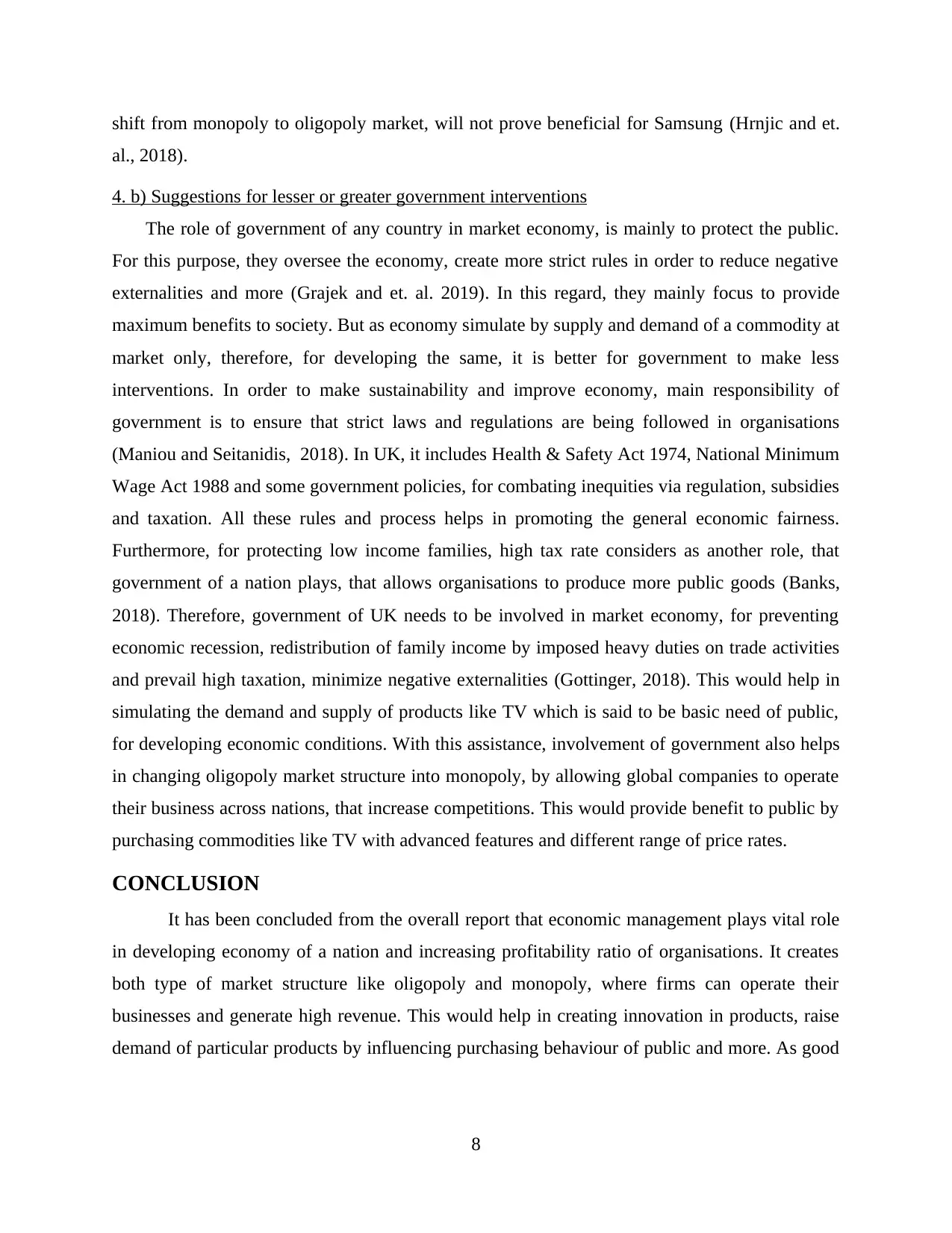
shift from monopoly to oligopoly market, will not prove beneficial for Samsung (Hrnjic and et.
al., 2018).
4. b) Suggestions for lesser or greater government interventions
The role of government of any country in market economy, is mainly to protect the public.
For this purpose, they oversee the economy, create more strict rules in order to reduce negative
externalities and more (Grajek and et. al. 2019). In this regard, they mainly focus to provide
maximum benefits to society. But as economy simulate by supply and demand of a commodity at
market only, therefore, for developing the same, it is better for government to make less
interventions. In order to make sustainability and improve economy, main responsibility of
government is to ensure that strict laws and regulations are being followed in organisations
(Maniou and Seitanidis, 2018). In UK, it includes Health & Safety Act 1974, National Minimum
Wage Act 1988 and some government policies, for combating inequities via regulation, subsidies
and taxation. All these rules and process helps in promoting the general economic fairness.
Furthermore, for protecting low income families, high tax rate considers as another role, that
government of a nation plays, that allows organisations to produce more public goods (Banks,
2018). Therefore, government of UK needs to be involved in market economy, for preventing
economic recession, redistribution of family income by imposed heavy duties on trade activities
and prevail high taxation, minimize negative externalities (Gottinger, 2018). This would help in
simulating the demand and supply of products like TV which is said to be basic need of public,
for developing economic conditions. With this assistance, involvement of government also helps
in changing oligopoly market structure into monopoly, by allowing global companies to operate
their business across nations, that increase competitions. This would provide benefit to public by
purchasing commodities like TV with advanced features and different range of price rates.
CONCLUSION
It has been concluded from the overall report that economic management plays vital role
in developing economy of a nation and increasing profitability ratio of organisations. It creates
both type of market structure like oligopoly and monopoly, where firms can operate their
businesses and generate high revenue. This would help in creating innovation in products, raise
demand of particular products by influencing purchasing behaviour of public and more. As good
8
al., 2018).
4. b) Suggestions for lesser or greater government interventions
The role of government of any country in market economy, is mainly to protect the public.
For this purpose, they oversee the economy, create more strict rules in order to reduce negative
externalities and more (Grajek and et. al. 2019). In this regard, they mainly focus to provide
maximum benefits to society. But as economy simulate by supply and demand of a commodity at
market only, therefore, for developing the same, it is better for government to make less
interventions. In order to make sustainability and improve economy, main responsibility of
government is to ensure that strict laws and regulations are being followed in organisations
(Maniou and Seitanidis, 2018). In UK, it includes Health & Safety Act 1974, National Minimum
Wage Act 1988 and some government policies, for combating inequities via regulation, subsidies
and taxation. All these rules and process helps in promoting the general economic fairness.
Furthermore, for protecting low income families, high tax rate considers as another role, that
government of a nation plays, that allows organisations to produce more public goods (Banks,
2018). Therefore, government of UK needs to be involved in market economy, for preventing
economic recession, redistribution of family income by imposed heavy duties on trade activities
and prevail high taxation, minimize negative externalities (Gottinger, 2018). This would help in
simulating the demand and supply of products like TV which is said to be basic need of public,
for developing economic conditions. With this assistance, involvement of government also helps
in changing oligopoly market structure into monopoly, by allowing global companies to operate
their business across nations, that increase competitions. This would provide benefit to public by
purchasing commodities like TV with advanced features and different range of price rates.
CONCLUSION
It has been concluded from the overall report that economic management plays vital role
in developing economy of a nation and increasing profitability ratio of organisations. It creates
both type of market structure like oligopoly and monopoly, where firms can operate their
businesses and generate high revenue. This would help in creating innovation in products, raise
demand of particular products by influencing purchasing behaviour of public and more. As good
8
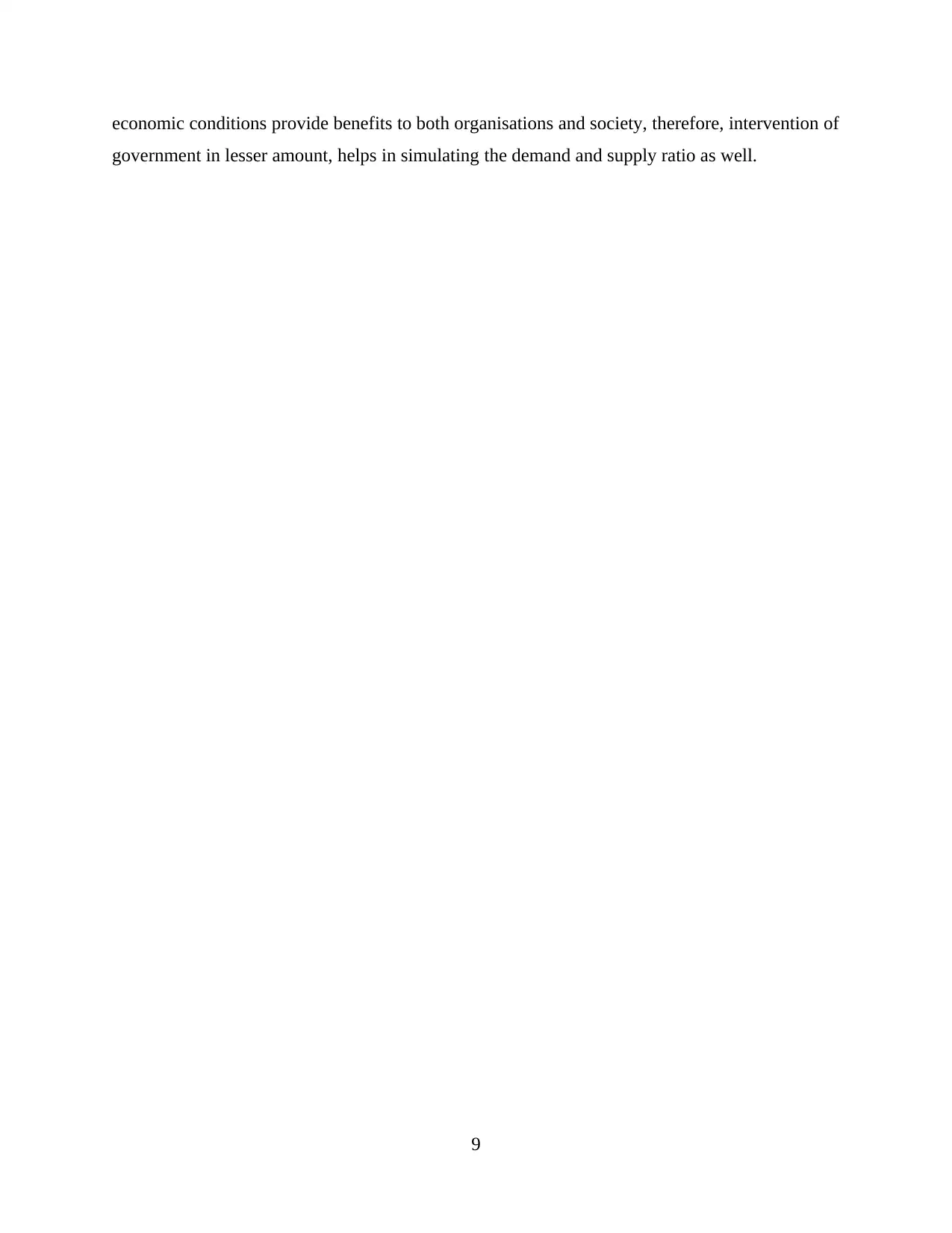
economic conditions provide benefits to both organisations and society, therefore, intervention of
government in lesser amount, helps in simulating the demand and supply ratio as well.
9
government in lesser amount, helps in simulating the demand and supply ratio as well.
9
⊘ This is a preview!⊘
Do you want full access?
Subscribe today to unlock all pages.

Trusted by 1+ million students worldwide
1 out of 13
Related Documents
Your All-in-One AI-Powered Toolkit for Academic Success.
+13062052269
info@desklib.com
Available 24*7 on WhatsApp / Email
![[object Object]](/_next/static/media/star-bottom.7253800d.svg)
Unlock your academic potential
Copyright © 2020–2026 A2Z Services. All Rights Reserved. Developed and managed by ZUCOL.





